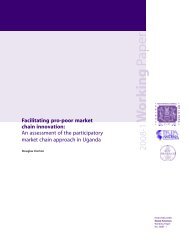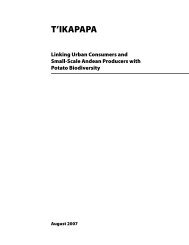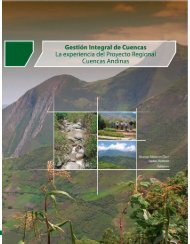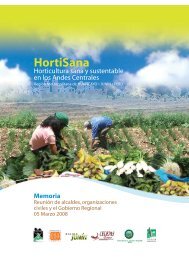An urban agricultural model in the making:Kampala, UgandaIn the last decade, the recognition among varioussectors <strong>of</strong> the population and among national and localgovernment agencies in Uganda, as to the benefits <strong>of</strong>attending, protecting and promoting urban and periurbanagriculture, has served as an example for humandevelopment efforts and strategies worldwide. Therecent legislative changes in Kampala, the role <strong>of</strong> thevarious civil societies’ organisations, includinginternational organisations, not to mention the efforts<strong>of</strong> the urban farmers themselves, have jointly begun theestablishment <strong>of</strong> a healthier, more sustainable andenvironmentally friendlier urban agricultural model, aswell as a more comprehensive approach to agriculturaldevelopment.37<strong>Urban</strong> <strong>Agriculture</strong>, as defined by the United NationsDevelopment Program (UNDP) (1998) 1 , has always beena part <strong>of</strong> Kampala’s economy. <strong>Urban</strong> and peri-urbanagriculture and livestock (UPA &L) is widely practised asan intense livelihood strategy in Kampala. This is due toa number <strong>of</strong> factors, including the rapid economicdecline in the early 1970’s, rural-urban migration, andthe city’s growth that engulfs large agriculturalfarmlands. According to the 2002 Population andHousing Census, Kampala’s population growth <strong>of</strong> 3.9%derives mostly from rural-urban migration. There is anunemployment rate <strong>of</strong> 42.5%, and over 80% <strong>of</strong> thepopulation are in the low-income bracket while 38.9%live in absolute poverty. Approximately 35% householdswith backyard gardens <strong>of</strong> less than an acre practiseUPA&L as their livelihood strategy.However, in Kampala, as in most African countries, thebenefits <strong>of</strong> UPA&L have been largely shadowed by itsrisks. <strong>Agriculture</strong> in Uganda has been, until recently,promoted only in rural areas through national policiesthat sought to develop strategic plans to eradicatepoverty. Under the “Town and Country Planning Act.1964” and the “Public Health Act. 1964”, urban agriculture1 United Nations Development Program 1988. “Potential, problems, and policy implications for urban agriculture in developing countries”.<strong>Agriculture</strong> and Human ValuesVol.20, No.1
38was widely seen as an illegal activity even though it wasnot per se prohibited. Concerns about urban agriculturewere based on perceived public health issues, includingthe dangers <strong>of</strong> creating environments for breedingmosquitoes, harbouring vermin, pollution from poorlydisposed livestock wastes and general nuisance frompoorly managed livestock. Even though UPA&L activitycontinues to grow, it is perceived to be neither consistentwith a modern productive city environment nor anactivity that can make a significant economiccontribution.In the early 1990’s both formal and informal initiatives torecognize UPA&L started, for example, the “cow bank”project <strong>of</strong> the National Assembly for the Kampala districtand also similar projects implemented by the civil societyorganisation, Environment Alert. The country’sdecentralisation process has allowed for local initiativessuch as the district agricultural extension <strong>of</strong>ficer workingunder the Kampala City Council (KCC) to build capacityfor urban harvest work in collaboration with nongovernmentorganizations (NGOs) as well as awarenessbuilding for local politicians. UPA&L initiatives like thesehave consequently brought about other challenges, suchas clashes between district and central government<strong>of</strong>ficials and the city <strong>of</strong>ficials whenever UPA&L related lawswere enforced, or such as UPA&L related promises andbribery with small livestock for votes during local elections.However, public and political awareness and greaterunderstanding <strong>of</strong> the dynamics <strong>of</strong> UPA&L are part <strong>of</strong> thechange process that has, since then, led to importantstructural policy changes in favour <strong>of</strong> UPA&L. Theawareness creation and sensitisation can be seen as aproduct <strong>of</strong> the greater amount <strong>of</strong> information, detaileddiagnostics and research carried out on the issues <strong>of</strong>UPA&L by various actors.The creation <strong>of</strong> <strong>Urban</strong> Harvest as a Strategic Initiative on<strong>Urban</strong> and Peri-<strong>Urban</strong> <strong>Agriculture</strong> meant more systematicand coordinated international research on issues <strong>of</strong>urban agriculture, which in turn led to a series <strong>of</strong>initiatives <strong>of</strong> international and regional meetings andworkshops up to the early 2000s. In these meetingsand workshops, Uganda’s research community, NGOs,technical <strong>of</strong>ficers and politicians had the opportunityto interact, learn, share and be exposed to experiencesin other countries as well as gain an understanding <strong>of</strong>urban agriculture.In 2002, a coalition <strong>of</strong> research actors, MakerereDepartment <strong>of</strong> <strong>Agriculture</strong> Extension, <strong>International</strong>Institute <strong>of</strong> Tropical <strong>Agriculture</strong>, (IITA) -Foodnet,National Agricultural Research Organisation (NARO,)KCC and two NGOs started to work on the project“Strengthening <strong>Urban</strong> <strong>Agriculture</strong> in Kampala,Uganda” which in general consisted <strong>of</strong> generatinginformation to assist local authorities, policy makers,NGOs and researchers. Another collaborative projectalso started that year that intended to understand thehealth risks and benefits <strong>of</strong> UPA&L and options forenhancing the benefits and minimizing the risks. Thecoalition <strong>of</strong> this project included the MakerereUniversity, KCC, Environmental Alert, <strong>International</strong>Livestock Research Institute (ILRI) and funded byCanadian <strong>International</strong> Development Agency (CIDA),<strong>International</strong> Development Research Centre (IDRC)and <strong>Urban</strong> Harvest.Links were made between these projects and a coregroup <strong>of</strong> local organisations developed, at first asinformal linkages, later formally, as the HealthCoordinating Committee (HCC). The committee,whose members include Makerere University, KCC and<strong>Urban</strong> Harvest among others, provided direct linksbetween research and development activities andpolitical awareness <strong>of</strong> the issues at a high level andthus played a major role in the policy change process.The committee later developed into an independentorganisation under the name <strong>of</strong> Kampala <strong>Urban</strong> Food
- Page 1 and 2: Impacts of urbanagricultureHighligh
- Page 3 and 4: 2Impacts of urban agricultureHighli
- Page 6 and 7: IntroductionThe CGIAR 1 System-wide
- Page 8: 7RESEARCH FRAMEWORKThe Urban Harves
- Page 11 and 12: Flower power in the Philippines:Str
- Page 13 and 14: 12At the policy level, CIP-UPWARD-U
- Page 16 and 17: tours offered all over the country.
- Page 18 and 19: Identifying best bet marketingoppor
- Page 20 and 21: What should I feed my child?Percept
- Page 22 and 23: Introduction to Urban ecosystems he
- Page 24 and 25: Pesticide-related health hazards ar
- Page 26 and 27: test whether contamination was redu
- Page 28 and 29: Dirty secret treasures in NairobiNa
- Page 30 and 31: The chaotic state of solid waste ma
- Page 32 and 33: themselves, both recently harvested
- Page 34 and 35: Introduction to stakeholderand poli
- Page 36 and 37: invited to attend this public prese
- Page 40 and 41: Security, Agriculture and Livestock
- Page 42 and 43: KARI in July 2004. One of the recom
- Page 44 and 45: NetworkingLocal and global networki
- Page 46 and 47: Networking and capacity building ac
- Page 48 and 49: 47Final Stakeholder Workshop on Iss
- Page 50 and 51: LATIN AMERICA49Activities Location
- Page 52 and 53: 51Foro Electoral Políticas y Compr
- Page 54 and 55: Dubbling M., G. Prain, M. Warnaars,
- Page 56 and 57: Peters, D., Ngai, DO Duc 2004 Agro
- Page 58 and 59: University of the Philippines,Dilim
- Page 60 and 61: Investment partners59Bundensministe
- Page 62 and 63: STUDENTS AND INTERNS61LimaTomás Al
- Page 64 and 65: Abbreviations and acronymsCEPISCESA
- Page 66: Urban Harvest is the CGIAR system w
















